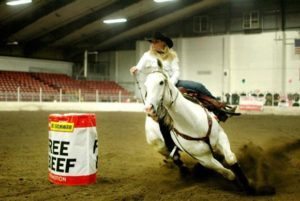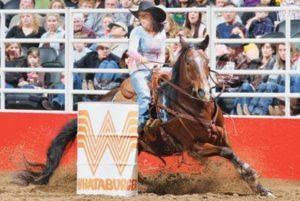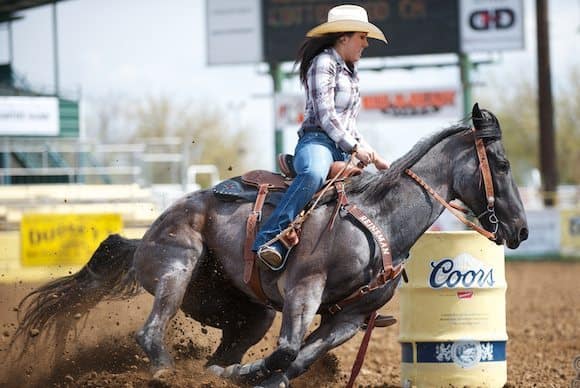Saddle Pads for Barrel Racing
Saddle Pads for Barrel Racing
Barrel racing is one of today’s most popular timed speed events, where men and women of all ages and skill levels can compete against one another for the fastest time. The barrel pattern is a clover leaf shaped course that a contestant must run either one right turn and two left turns, or, one left turn and two right turns.
Some barrel racers start at a young age and continue throughout their lives to make a career out of the sport. Although men can compete at some amateur venues and other jackpot races, barrel racing was actually made for women by women so they can compete in rodeos too. Men dominated the rodeo sport back in the day as they roped steers, rode bulls and rode broncs, and women didn’t exactly want to participate in these types of rodeo events, therefore, the Girls Rodeo Association; now commonly known as the Women’s Professional Rodeo Association (WPRA) was developed by a group of women in Texas in 1948, where it is said that the first barrel race was held.
Since the sport of barrel racing has been developed, the sport has spread worldwide and now different countries have their own barrel racing events, rodeos and associations. At Rodeo’s, contestants are required to follow a dress code of a long sleeve western shirt, boots, a hat and jeans. Not following the dress code can result in a penalty or a disqualification from that day’s event. The object of the barrel pattern is to follow the correct course pattern and run the fastest time with all three metal barrels up; knocking a barrel down results in a five second penalty added to your time, which is normally too slow to place and some competitors consider it a no time.
Barrel racers that are involved with the WPRA compete for the fastest time and most career earnings within the barrel racing season and a lifetime. Twelve divisional circuits break up the WPRA across the country and the average and overall winners, in their circuit, go on to compete in the Circuit Finals Rodeo. Most, if not all barrel racers, dream is to qualify and compete in the Wrangler National Finals Rodeo held in Las Vegas, Nevada. Only the top 15 barrel racers in the country make it to the finals every year. There, they are still competing for the most career earnings and hope to be the top ranked cowgirl of the year. All of these girls are aiming to win one of those famous gold buckles and claim the world title for barrel racing. Most barrel racers and other rodeo contestants couldn’t do what they do and travel as much as they do without sponsors from different companies.
Some barrel racers and team roping riders that we proudly sponsor include, Sheena Robbins, Jade Corkill, Lance Graves, Spencer Mitchell, Nellie Williams, Angie Meadors, Camish Jennings, Lita Scott, Cesar De La Cruz, Jackie Gudmundson Taylor Rivera and Caitlyn Wood, all competing to be the best of the best.



Barrel Racing: What is it?
It’s a sport where the winner can be determined by literally thousandths of a second. That being said, the relationship between the horse and rider is so much more than crucial. The limits of both horse and rider are constantly tested – both mentally and physically. The horse’s athleticism and mental condition, and the rider’s horsemanship skills all affect their run as they wind through a clover leaf pattern at top speeds. Although the event does not require many props, the flexibility, agility, and balance of both horse and rider are crucial. The course includes three 55-gallon barrels placed in a triangle in the middle of a (well-groomed) arena. The rider runs into the area with the clock, which is generally an electronic eye, starting as soon as the team crosses the ‘start’ line,’ and ends after circling each barrel and running home across the ‘finish’ line. The rules are simple – with no subjective points of view, only the clock. The team that lays down the fastest time with the tightest turns, most efficient communication, and no overturned barrels wins. Every knocked barrel results in a penalty of five seconds, but in the barrel racing world literally every second counts!
The History of Barrel Racing
Up until the 1920s it was considered ‘unladylike’ for women to ride horses, but a turn of events in the twentieth century led to a sort of golden age for women in rodeo. Around 1928 barrel racing, the first ever sport for women on horseback, was invented. Although it is difficult to pinpoint the exact origin of barrel racing, world champion barrel racer Martha Josey said, “It probably started out as pretty women [fusion_builder_container hundred_percent=”yes” overflow=”visible”][fusion_builder_row][fusion_builder_column type=”1_1″ background_position=”left top” background_color=”” border_size=”” border_color=”” border_style=”solid” spacing=”yes” background_image=”” background_repeat=”no-repeat” padding=”” margin_top=”0px” margin_bottom=”0px” class=”” id=”” animation_type=”” animation_speed=”0.3″ animation_direction=”left” hide_on_mobile=”no” center_content=”no” min_height=”none”][sitting] on fast horses, but now it’s a competitive sport for serious athletes.” Barrel racing was originally a women’s-only event, while men participated in more hands-on events. At the time the event alternated between a figure-eight and clover leaf pattern. Speeds was not as much a factor in the results as was the rider’s outfit and horsemanship. By 1948 however, a group of 38 cowgirls in San Angelo formed the Girl’s Rodeo Association (GRA) and in 1949 barrel racing officially became all about the need for speed. Today the GRA has developed into the Women’s Professional Rodeo Association (WPRA). The WPRA is split into 12 circuits and hosts over 800 events a year with a payout of over three million dollars. Average and overall winners compete at the Ram National Circuit Finals Rodeo.
Barrel Racing Today
While the event was originally developed for cowgirls only, modern barrel racing is open to girls, boys, men and women of all ages and levels of experience including weekend riders and professionals, with payouts and award packages far surpassing ~$250,000 in several associations. Barrel racers at all levels of competition must pay attention to detail while maneuvering at such high speeds. Although the rider is allowed to choose whether to turn right or left at their first barrel, precise control is absolutely required to win. Running past a barrel or off course will result in a time penalty or a disqualification altogether.
A Good Barrel Horse
Although speed is important, control is key the key to barrel racing. It is easy to lose control running at such high speeds. Therefore the riders must train their hoses to respond to certain cues – cues that help the horse approach the barrels in a pocket and not lean in too far. Horses need to understand how to adjust to these cues at each of the three barrels and then simultaneously understand how to accelerate to the next barrel only to be checked up again in a few short seconds. Barrel horses must be able to speed into turns – turns that are often poorly lit depending on the kind of arena. The ground may be slippery or poorly turned – falls can happen. A good barrel horse though, is sure of his feet and digs in deep for a good grip.
Need some tips on what saddle pad to select? Click here for saddle pad fitting tips.[/fusion_builder_column][/fusion_builder_row][/fusion_builder_container]
